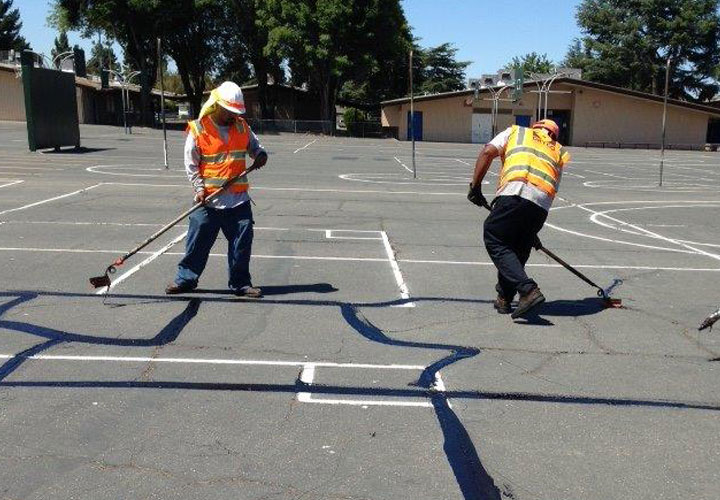Understanding Tilted Parking: How Asphalt Sealing Boosts Business Whole Lots
Understanding Tilted Parking: How Asphalt Sealing Boosts Business Whole Lots
Blog Article
Hot Mix Asphalt: A Sustainable Service for Sidewalk
Hot Mix Asphalt (HMA) has actually arised as a leading sustainable option for pavement options, offering a myriad of innovative technologies and ecological benefits. As the need for environmentally friendly building and construction methods grows, exploring the nuances of HMA's sustainability can supply valuable understandings into the future of pavement services.
Ecological Benefits of Hot Mix Asphalt

Furthermore, Hot Mix Asphalt helps to minimize urban warmth island impacts. Its dark shade soaks up sunshine, lowering the amount of heat showed back right into the atmosphere contrasted to lighter-colored pavements. This can decrease ambient temperature levels in urban areas, lowering the demand for cooling and ultimately minimizing energy intake.
Additionally, Warm Mix Asphalt contributes to boosted stormwater management. Its porous nature permits water to reenergize and penetrate the sidewalk groundwater products, reducing drainage and the threat of flooding. These ecological benefits make Warm Mix Asphalt a sustainable selection for paving highways and roads.
Power Efficiency in HMA Production
Is power efficiency an essential element in the manufacturing of Warm Mix Asphalt (HMA)? Energy plays a substantial function in the manufacturing of HMA, affecting both expense and environmental sustainability. One vital aspect of power performance in HMA production is the usage of cozy mix asphalt (WMA) modern technologies.
Additionally, improvements in plant modern technologies have actually resulted in even more energy-efficient HMA manufacturing procedures. Modern plants are designed with attributes like recycled asphalt sidewalk (RAP) handling capacities, reliable burner systems, and improved insulation, all contributing to energy savings. By optimizing energy use in HMA production, the industry can minimize its carbon footprint while preserving top notch sidewalk materials. Power efficiency is, therefore, a crucial factor to consider in ensuring the sustainability of Hot Mix Asphalt manufacturing.
Recyclability of Hot Mix Asphalt
The recyclability of Hot Mix Asphalt (HMA) is a crucial aspect of its sustainability and lasting environmental impact. HMA is among one of the most recycled materials in the United States, with over 100 million lots of reclaimed asphalt pavement (RAP) being reused every year in brand-new pavement building and construction. Reusing HMA uses numerous ecological advantages, such as reducing the need for virgin materials, decreasing power intake during production, and reducing the amount of waste sent out to garbage dumps.
The process of reusing HMA involves milling the existing pavement, squashing it into smaller pieces, and mixing it with brand-new accumulation and asphalt binder to create a recycled mix. In general, the recyclability of get more HMA plays a substantial role in advertising sustainable practices within the sidewalk market.

Long-Term Efficiency of HMA
Asphalt pavements show sturdiness and resilience over an extended duration, showing the long-term efficiency of Hot Mix Asphalt (HMA) Furthermore, innovations in HMA technology, such as the usage of polymer-modified binders and cozy mix asphalt, have even more enhanced the resilience and durability of HMA pavements. By focusing on quality building and upkeep techniques, HMA continues to show itself as a sustainable and economical service for durable pavement framework.

HMA: Sturdiness and Sustainability
Showing both resilience and sustainability, Warm Mix Asphalt (HMA) has become a keystone in the building of resilient sidewalk facilities - regrading. HMA's longevity originates from its capacity to hold up against heavy lots, extreme climate condition, and high website traffic volumes, making it a trusted choice for streets, highways, and airport paths. The structure of HMA, which usually consists of accumulations, binder, and filler, plays an important his explanation role in boosting its long life and resistance to tear and wear
Furthermore, HMA's sustainability depends on its recyclability and energy-efficient production procedure. The capability to reuse recovered asphalt pavement (RAP) in brand-new HMA blends reduces the need for virgin products and reduces the ecological effect of sidewalk building and maintenance. In addition, the energy efficiency of creating HMA hinges on its lower blending temperatures compared to various other pavement products, resulting in lowered power intake and greenhouse gas discharges.
Final Thought
In conclusion, hot mix asphalt (HMA) uses a lasting solution for pavement with its eco-friendly attributes. HMA's recyclability, power performance in manufacturing, and lasting longevity make it an environmentally friendly option for road construction. By preserving natural resources, decreasing waste, and reducing greenhouse gas emissions, HMA plays an essential role in advertising sustainability in facilities advancement. Its capacity to minimize city warm island results even more underscores its significance in developing resistant and ecologically conscious sidewalk systems.
HMA is one of the most recycled materials in the United States, with over 100 million bunches of recovered asphalt pavement (RAP) being recycled yearly in brand-new sidewalk building.The procedure of reusing HMA entails crushing the existing pavement, crushing it right into smaller items, and blending it with brand-new accumulation and asphalt binder to produce a recycled mix.Asphalt sidewalks demonstrate longevity and durability over an extensive period, showing the long-lasting performance of Hot Mix Asphalt Website (HMA) In addition, developments in HMA technology, such as the use of polymer-modified binders and warm mix asphalt, have actually further boosted the resilience and longevity of HMA pavements. The capability to recycle reclaimed asphalt pavement (RAP) in new HMA mixtures lowers the demand for virgin products and reduces the ecological impact of sidewalk building and maintenance.
Report this page